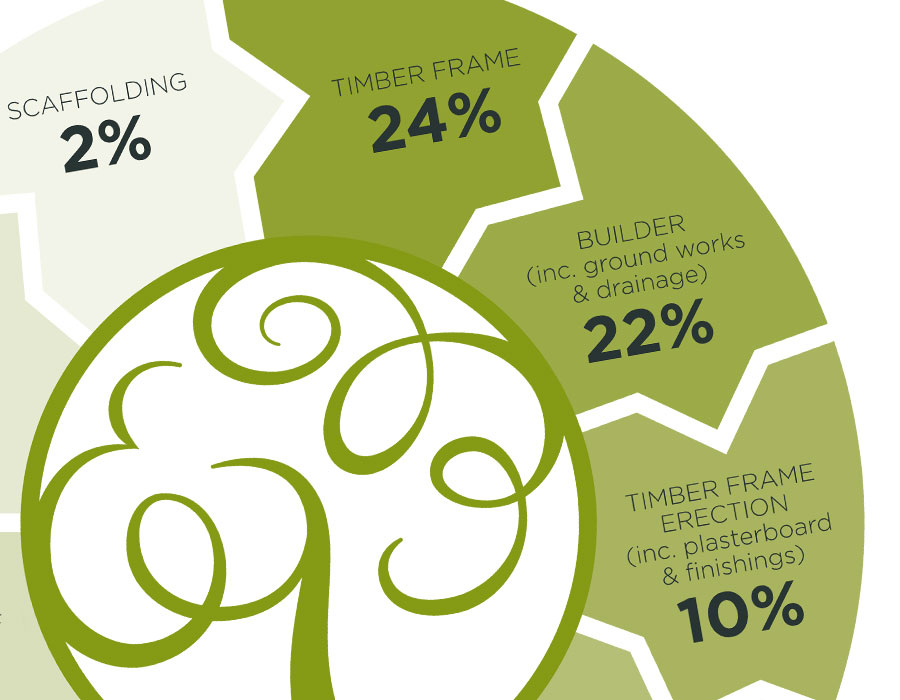Building your timber frame self-build budget for project success

Sitting down to create your first self-build budget can seem like a daunting process. Here we offer a few easy steps to get you from the back of an envelope calculation to an initial ballpark budget.
Understand what you can afford to build from the off.
While this sounds obvious, you’d be surprised how many people end up shelling out on architectural drawings for a property they simply can’t finance. In addition to slowing down your project’s momentum, it’s also a criminal waste of your budget. An important factor in helping you to understand what a realistic project looks like is a good grasp of the relationship between size and cost.
Getting to grips with size and cost
A good place to start is online. Use our self-build cost calculator to input a floor area (which should include all of your storeys, so ground floor, first floor, second floor etc) which will give you a per m² ball park figure for the total build cost, excluding the cost of the land. The guideline cost per m² will be based on the build route you choose.
What build route is right for me?
How you choose to manage your build will influence cost significantly. You could be looking at £1000 per m² if you’re happy to be very hands-on, or £1800 per m² and above if you’d prefer to let someone else do the heavy lifting. Your choice of build route will be influenced by a variety of factors not just cost. Working full time in a demanding job, juggling a busy household, family commitments, your project management skills or health factors may all play a role in shaping your decision making. The critical step is choosing the route that will provide you with the best value relative to your personal circumstances.
What size is right?
The average size of a new build home in the UK is 76m². The average self-build home is 247m². That’s 3.25 times bigger! Ideally, you should be aiming to build a home that balances your aspirations for living with what you can afford to build, but it can be difficult to get a sense of scale when it comes to size versus space. One of the best ways to master this is to measure each room in your existing home. Where do you need more or less space? This should help you to arrive at an optimum total floor area.
Sense checking
If you need to revisit the cost calculator, you can now type in your ideal floor area and preferred build route and adjust according to your available finances. At this stage, it’s important to remember that your final budget will depend on a host of additional elements, including the type of house you want to build, its complexity, the location of your plot, your specification, and your design method. What we are aiming to achieve here is a ‘typical’ ballpark budget by way of a starting point.
Now I have a ballpark figure, how do I break this down, so that I know what I need to spend where?
There’s a helpful graphic of how costs typically break down in a timber frame self-build home on our website. While these figures should only be viewed as indicative, they provide a useful overview of what proportion of your budget is required where. The next stage is to achieve more granular detail for each of the section headings. That’s where the self-build research comes in…
Article Archives
- 31 January Get Started with your Self-Build Design
- 11 October Making self-build more straightforward
- 13 March NSBRC Building Systems Workshop
- 03 March Self-Build Pre Planning Advice
- 07 December External Wall Build Ups Explained
- 19 October NaCSBA’s Custom and Self Build Conference
- 22 September Our Saltire Scholar 2022
- 21 September Planning permission explained
- 23 August Fundraising for Marie Curie
- 17 August Carbon Capture and Storage
- 15 March The Case for Project Management
- 03 February Financing your self-build with a mortgage
- 15 October Custom Build Collaboration for West Cumbria
- 17 March Tackling timber frame terminology
- 06 October Exhibitors and experts line up at the NSBRC
- 26 March Tips for working from home
- 16 November Top Tips When Planning Your Build
- 25 September Is timber frame the same as a pre-fab?
- 09 April Boost Your Self-Build Knowledge
- 08 February Can a timber frame home stand the test of time?
- 15 January Self-build mortgages: what you need to know
- 23 February Cut on-site costs with FIT pre-insulated panels
- 03 January Bespoke self-build checklist
- 07 November Custom build vs self-build
- 07 April The three timber frame build routes
- 10 August A Scottish model for an English market
- 18 September 3 essentials for self-build success